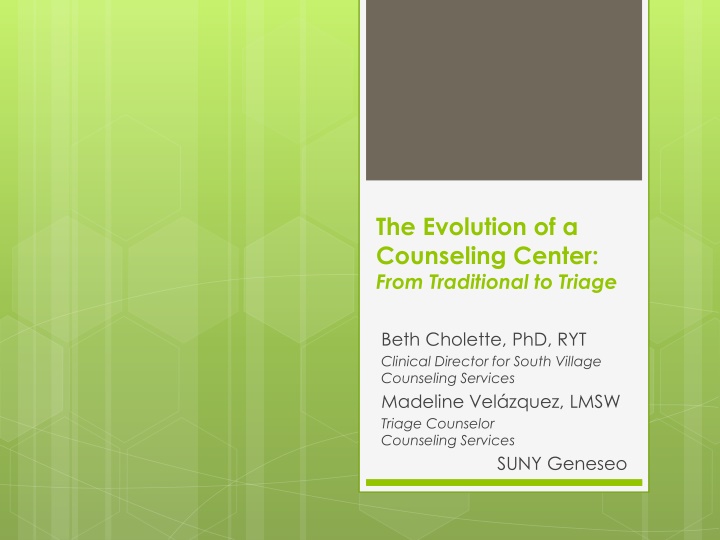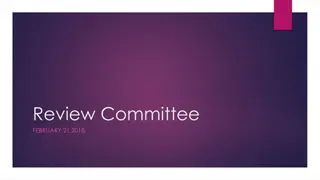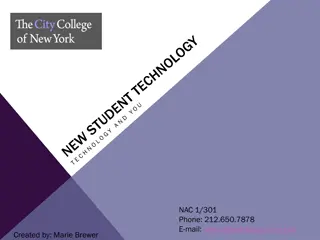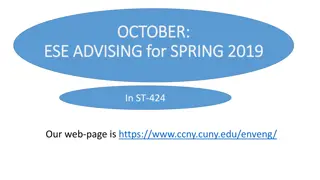
Evolution of Counseling Centers: Transitioning to Triage-Based Models
Explore the journey of counseling centers shifting from traditional intake-focused models to triage-based approaches. Learn about the benefits, challenges, and strategies for enhancing mental health services in educational institutions.
Download Presentation

Please find below an Image/Link to download the presentation.
The content on the website is provided AS IS for your information and personal use only. It may not be sold, licensed, or shared on other websites without obtaining consent from the author. If you encounter any issues during the download, it is possible that the publisher has removed the file from their server.
You are allowed to download the files provided on this website for personal or commercial use, subject to the condition that they are used lawfully. All files are the property of their respective owners.
The content on the website is provided AS IS for your information and personal use only. It may not be sold, licensed, or shared on other websites without obtaining consent from the author.
E N D
Presentation Transcript
The Evolution of a Counseling Center: From Traditional to Triage Beth Cholette, PhD, RYT Clinical Director for South Village Counseling Services Madeline Vel zquez, LMSW Triage Counselor Counseling Services SUNY Geneseo
2 The presenters have no actual or potential conflict of interest in relation to this program/presentation.
3 Learning Objectives Participants will demonstrate understanding of the difference between an intake-focused model of services versus a triage-based model. Participants will be able to describe the current service model at their institution and compare to the model presented. Participants will be able to identify the systematic benefits of a triage-based model. Participants will be able to identify 1-3 ways to enhance or update services at their institution.
4 What We Did Before A.K.A Back in My Day 1995-2010: Client first contact = Intake appointment 3 FTE counselors, all conduct Intakes Clients see Intake counselor for ongoing therapy
5 Starting to Evolve: First Attempt (2011-16) Client first contact = MEETing Meet, Evaluate, Educate, Treat How MEETings were more triage-like: More frequent appointments available Less forms for clients to complete upon arrival Shorter appointments (still scheduled full hour, but 30-40 minutes with client) Shorter summary report by counselor Clients engaging in therapy referred for Intake appointment, usually with same counselor
6 Starting to Evolve: What Went Well Decreased wait time for initial MEETing appointments (at least at first!) Increased focus on single-session intervention (problem-solving) Switching to a biweekly model for ongoing therapy allowed greater flexibility Presenting utilization data to administration resulted in new FTE position (August 2013)
7 Starting to Evolve: Perils and Pitfalls Decreased throughput (scheduling for therapy after initial appointment) despite improved input (initial MEETing session) New FTE availability quickly outpaced by growing utilization numbers Wait times for initial MEETing eventually increased from 2-3 days to 1-2 weeks Student reluctance to follow through with off-campus referral recommendations
8 Continued Evolution: Why Change? Perils and Pitfalls! Increasing Utilization:* 16.1% increase in total number of counseling appointments (Fall 2015=983, Fall 2016=1141) Areas of increase: Crises=92.7% Case Follow-Up=26.3% Intakes=2.8% Individual Ongoing=39.1% *Based on SUNY Geneseo Counseling Services data, Fall 2015 vs. Fall 2016
9 Continued Evolution: Why Change?, continued National trends: Source: The Association for University and College Counseling Center Directors Annual (AUCCCD) Survey, July 1, 2016 through June 30, 2017 For schools that have 5001-7500 students: Mean number triage appointments: 200 (454) Medium number individual: 1698 (703) Mean number crisis appointments: 106.8 (54) Median number psychiatric: 184 (84) (Parenthetical numbers based on Geneseo, Fall 2017)
10 Continued Evolution: Why Change?, continued Increasing symptom severity: Source: American College Health Association-National College Health Assessment II (ACHA-NCHA II), Conducted at Geneseo Spring 2018 70% Felt overwhelming anxiety 57% Felt things were hopeless 47% Felt so depressed it was difficult to function 15% Seriously considered suicide 12% intentionally injured (cutting, burning, etc.) 75% identified at least one life issue (academics, family, interpersonal, sleep, health, etc.) as being traumatic or very difficult to handle 56% reported dealing with 3 or more issues
13 Becoming Agents of Change Approval to add three new FTE lines in February 2016 Two of three FTE lines designated as triage counselors (a.ka. jack of all trades ) Plan to have two new triage counselors manage all initial triage, all walk-ins, all crises, all referrals and pretty much anything else we could get them to do!
14 Plan Versus Reality
15 So What do the Triage Counselors REALLY do?
16 Prevention / Intervention / Postvention Prevention Coordinator of Health Promotion - Wellness Outreach Triage Counselors as psycho-educators - Campus Outreach Programming and Initial Triage Appointments Intervention Triage Counselors provide Crisis Appointments Short Term Counselors Psychiatrist (triage does not refer directly to psychiatry) Postvention Triage Counselors provide Case Management: Gap sessions Post-Hospitalization Discharges Referral from short term counseling to community based higher level of services
17 Single versus Dual Triage Provisions One On-Staff Triage Counselor Two On-Staff Triage Counselors Scheduling backup provisions - Yes Ability to perform campus outreach combined with psycho-education - Yes Ability to allot case management specific time - Yes Resource building time - Yes Semester end assistance with Brief Counseling Appointments - Yes Pre-Triage Utilized Yes -
18 Pre-Triage / Purple Form If a triage appointment time is not immediately available for a walk-in, client reviews this form and the Backup On-Call Counselor completes a 5-minute pre-screening for services. By simply stating YES or NO, please let us know if any of the following items apply to your current situation: Recent suicide attempt/increase/thoughts/plans Self Injury within 24 hours Thoughts of SI/HI Concerned for safety of another Recent harm to your person Recent witnessing of violence Death of a loved one Hallucinations Out of control recreational drug use Need for hospital services
19 Defining Initial Care Level Defined As Appointment Time Active Mania, High Risk SI/HI, Severe Psychiatric Need, Special Referral for Assessment, Possible MHA needs, etc Immediate Care Emergency Defined by the client or referral source as needing prompt services Same Day to Next Day Crisis Request for initial counseling appointment Within 48 - 72 Hours On-Call
20 Adhesive Time Managing of a 45-Minute Triage Appointment 8 Minutes: Client Completes Documentation (questionnaire, CCAPS) 2 Minutes: Verbal Confidentiality Disclosure 15 Minutes: Case Discussion/Event/Symptoms/Background/Goals 10 Minutes: Risk Assessment 5 Minutes: Psychoeducation/Intervention 5 Minutes: Referral and Documentation
21 Triage Session Risk Assessment Assessing current and past ideation or events Self-Injurious Behaviors Suicidal Ideation/Attempts Homicidal Ideation/Attempts Eating Disorder Thoughts/Behaviors
22 Benefits of Dedicated Triage Counselor(s) Quicker access to care for first-time clients Higher utilization by those who previously did not access services (largely due to decreased wait times) Rapid screening of all new clients Greater dedication to client s presenting needs Improved referrals with limited resources, including faster connections and better follow-up Increased recognition of high acuity serviced Higher client satisfaction with services Improved overall perception of services
23 Hiring for Essential Skills Clinical Management Skills Rapid client sorting based on acuity Rapid assessment for appropriateness of short intervention Ability to provide Brief Timed Interventions Strong Counselor/Client matching Comfort providing Pre-Intake Diagnostic Assessment Comfort utilizing Motivational Interviewing, particularly when referring clients to community for higher level of care Ability to de-escalate clients in crisis Ability to manage MHA referrals while maintaining safety protocols
24 Hiring for Essential Skills, cont. Business Management Skills Ability for quick decision-making Appointment time management Ability to help client create and accept a strong disposition plan Strong follow up with referrals Generalist Skills Ability to represent and manage Equality/Equity Very broad knowledge and quick delivery of psychoeducation Burn Out Prevention Skills Ability to manage repeated crisis with high level of Self-Care
26 Smooth Beginnings Logistics Triage situated in front of center Triage offices next to Clinical Director System Change Buy-in Educate existing professional staff on change to a new Triage Model Evaluation and Supervision Schedule seperate supervision time (Triage Counselors/Clinical Directors) Assess Triage as a separate function (update departmental policies, QA, etc.)
27 Promoting the Approved Triage Model Campus department heads are introduced to upcoming system by Counseling Director Upon hire, new Triage Counselors are introduced to staff and faculty Triage Counselors meet with local community providers via: Hosting Meet and Greet on campus Onsite visits to community agencies Memorandum of Understanding (MOU) with hospitals and other large agencies
28 Any Questions? Follow-up Questions/Comments: (may also request copy of slideshow) Beth: Madeline: cholette@geneseo.edu velazquez@geneseo.edu




















